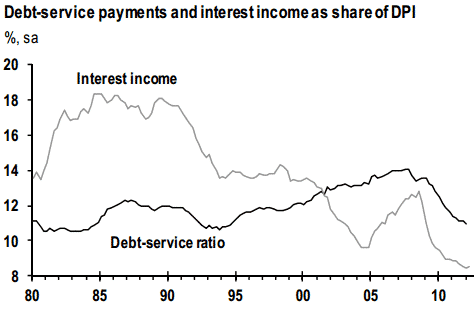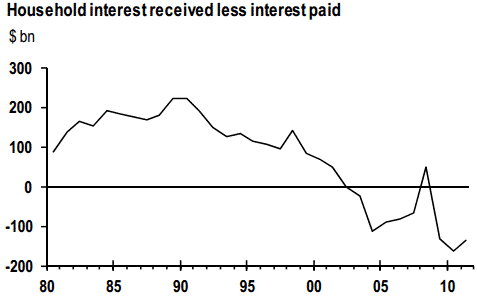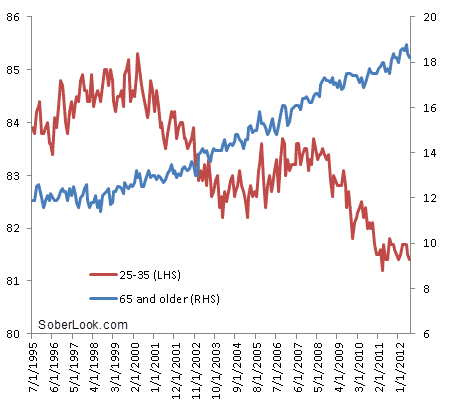The Fed’s zero rate policy is toxic for US household interest income
By Sober Look
Ben Bernanke (Reuters): "Interest rates are low because our economy is still in a fragile recovery," Bernanke told a town hall meeting in Washington with educators.
"Lower rates are intended to restore more normal levels of employment and growth."
That may be true, but on average a prolonged low interest rate environment has been hurting US households. Here is why.
Many economists point to the household debt-service ratio as an indication that low rates are helping consumers. The ratio has declined from the "bubble" years – roughly to the level it was in the 90s. It is true that one reason for this decline is the drop in interest rates (lower mortgage payments for example). But it’s not the only reason. The US consumer has deleveraged considerably since the financial crisis, reducing debt levels (lower credit card balances for example) and therefore lowering the debt-service ratio. This component of the reduction has nothing to do with lower interest rates.
Interest income as a percentage of disposable personal income (DPI) on the other hand had declined dramatically, far outpacing the decline in debt-service ratio. Consumers are not benefiting from the lower debt burden because their savings accounts are not paying them anything.
Source: JPMorgan
In fact net household interest income (interest received less interest paid) is near record lows (negative) in dollar terms. That’s money coming directly out of US consumers’ pockets.
Source: JPMorgan
A key negative side effect of persistently low rates on households is the delay of retirement. This inability of many Americans to retire on their savings because of low rates is keeping them in the workforce, limiting job opportunities for younger workers. In fact this increasing number of older participants in the workforce, likely at the expense of the younger workers, is visible in the labor participation rates (broken out by age).
Labor participation rates for younger and older Americans
(source: Bureau of Labor Statistics)
The low rate environment is not the only factor in the delay in retirement, but its impact is unmistakable.
Blake Hurst (the American Enterprise Institute): – In a recent Wells Fargo/Gallup survey, one in three investors report that low interest rates have forced them to delay retirement. Forty-two percent of people now investing say that low rates have made them doubt that their retirement savings will last as long as they will, and nearly 40 percent of retirees report reduced consumption because of low interest rates.
It is true that some households have been helped by record low mortgage rates. But on the whole, the consumer is worse off in a prolonged low interest rate environment. Therefore keeping rates low over the next few years is by no means a riskless strategy for the Fed, requiring a thorough cost-benefit analysis. There is no question however that the costs to US households will be significant.



This article leaves out a very important facet of interest rates: expected inflation. Interest income was much higher in the 70’s but inflation was also much higher. The high “interest income” mostly just kept the real value of people’s savings from going down.
The real variable is real interest rates, which have gone down but not by near as much as nominal rates. If the Fed targets inflation, then they don’t control the real interest rates. Real interest rates depend on how likely people are to save vs. spend. If people are more likely to spend, like the 70’s, then high real interest rates are needed to incentivize saving. With the global savings glut, people have wanted to save so badly that negative real rates have been needed to disincentivize savings enough to keep inflation on track.
Unlike the 70’s, when people had less propensity to save, high real rates would greatly reduce demand, bringing on deflation and severe economic pain. Real interest rates in fact skyrocketed in late 2008, as the TIPS market was forecasting tremendous deflation going forward. Even if rates are “low” at zero percent, deflation can still lead to high real rates.
How can Sober Look write an entire post about low interest rates and not ONCE mention the word “real”, and in “nominal” vs. “real”.
In addition, SL wrote: “But on the whole, the consumer is worse off in a prolonged low interest rate environment.” Care to support that bald assertion with evidence, analysis, or even a theoretical arguement?
If you are an existing debtor, the current interest rate environment is good for you. If you are an existing creditor, the current interest rate environment is not good for you. That is the fundamental underpinning of almost all of the government’s policies. And then SL focuses on only half of that calculus. Meaningless.
This article also avoids the fact that the real reason for ZIRP is to stop even further falls in real estate markets which would impose even greater losses on the banks. If interest rates were anything like normal then the numbers underwater would increase substantially as debt repayments would become onerous again. Real estate values would fall again and even returning to a long term sustainable level would impose such significant losses on the banks that solvency would be questionable for the biggest 22 US banks.